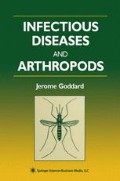Abstract
The condition of fly maggots infesting the tissues of people or animals is referred to as myiasis. Specific cases of myiasis are clinically defined by the affected areas(s) involved. For example, there may be traumatic (wound), gastric, rectal, auricular, and urogenital myiasis, among others. Although not an infectious disease in the strictest sense, myiasis cases are often seen by family physicians or infectious disease specialists. Myiasis can be accidental, when fly larvae occasionally find their way into the human body, or facultative, when fly larvae enter living tissue opportunistically after feeding on decaying tissue in neglected, malodorous wounds. Myiasis can also be obligate in which the fly larvae must spend part of their developmental stages in living tissue. Obligate myiasis is true parasitism and is the most serious form of the condition.
Access this chapter
Tax calculation will be finalised at checkout
Purchases are for personal use only
Preview
Unable to display preview. Download preview PDF.
References
Greenberg B. Two cases of human myiasis caused by Phaenicia sericata in Chicago area hospitals. J Med Entomol 1984; 21: 615.
United States Department of Agriculture, ARS, Agri. Hndbk. No. 655, Feb. 1991.
Merritt RW. A severe case of human cutaneous myiasis caused by Phaenicia sericata. Calif Vector Views 1969; 16: 24.
Richard RD, Ahrens EH. New distribution record for the recently introduced blowfly Chrysomya rufifacies in North America. Southwest Entomol 1983; 8: 216.
Goddard J. Human infestation with rodent botfly larvae: a new route of entry? S Med J 1997; 90: 254–255.
Anderson JF, Magnarelli LA. Hospital-acquired myiasis. Asepsis 1984; 6: 15.
Alexander JO. Arthropods and Human Skin. Springer-Verlag, Berlin, 1984.
Brewer TF, Wilson ME, Gonzalez E, Felsenstein D. Bacon therapy and furuncular myiasis. J Am Med Assoc 1993; 270: 2087.
Author information
Authors and Affiliations
Rights and permissions
Copyright information
© 2000 Springer Science+Business Media New York
About this chapter
Cite this chapter
Goddard, J. (2000). Myiasis. In: Infectious Diseases and Arthropods. Infectious Disease. Humana Press, Totowa, NJ. https://doi.org/10.1007/978-1-59259-721-5_8
Download citation
DOI: https://doi.org/10.1007/978-1-59259-721-5_8
Publisher Name: Humana Press, Totowa, NJ
Print ISBN: 978-1-4757-5461-2
Online ISBN: 978-1-59259-721-5
eBook Packages: Springer Book Archive

